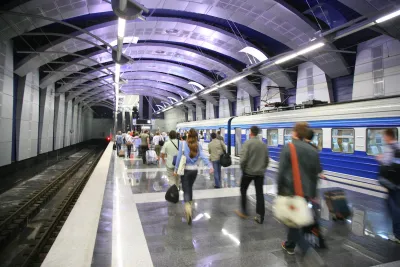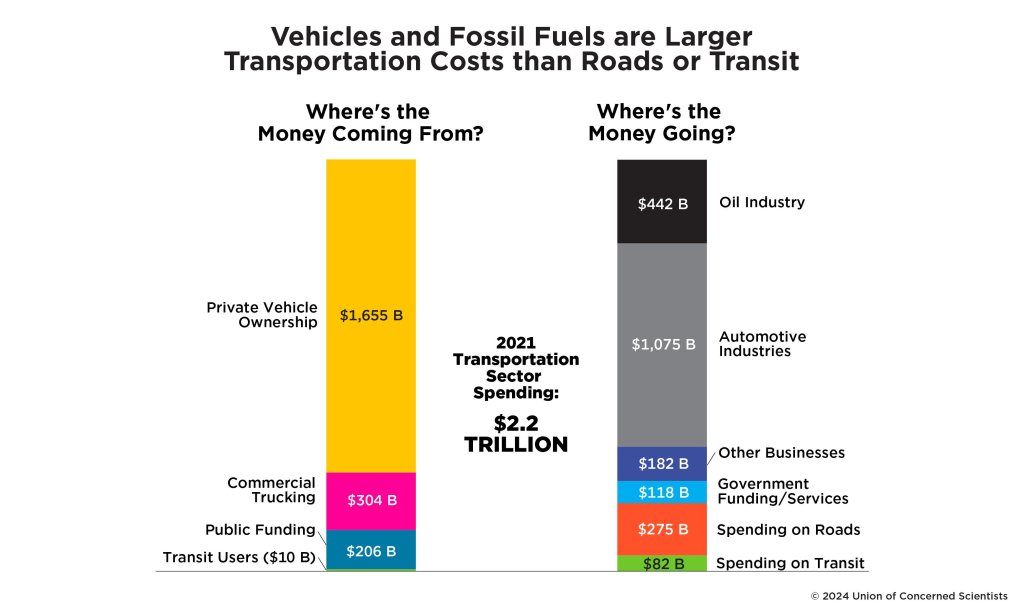This Union of Concerned Scientists study examines why and how to improve resource-efficient travel options to achieve diverse goals. It estimates that more efficient transport could save up to $201 billion in energy and $128 billion in health costs.

The new Union of Concerned Scientists study, Freedom to Move: Investing in Transportation Choices for a Clean, Prosperous, and Just Future, shows that a transportation system that gives everyone more transportation choices will be more equitable, save trillions of dollars, and fight climate change. More transportation options such as transit, walking and biking are good for the environment, economy, and social equity.
It finds that:
-
A system with improved transportation options and reduced driving could save up to $201 billion in energy infrastructure and $128 billion in public health costs through 2050, presenting a more effective climate solution than the current car-dependent model.
-
The auto and oil industries have a vested interest in car dependence, currently receiving more than 75 percent of public and private transportation spending and have lobbied for decades to prioritize cars over a more complete and affordable set of transportation options.
-
Science-based policies that prioritize more transportation choices align with community-based solutions where local advocates have long fought for a transportation system that prioritizes people over industry interests.

Recommendations
-
Invest in a complete set of transportation options for a system that offers abundant access to everywhere we need to go and promotes economically thriving communities in both urban and rural areas. This means investing in networks of safe sidewalks for pedestrians, paths for biking and micromobility, and frequent, wide-ranging, affordable, and clean public transportation. These efforts depend on promoting land use changes that allow people to live near high-quality transit without displacement, dismantling structural racism in community safety, and ensuring good jobs with high labor standards.
-
Prioritize transportation projects in rational ways, including the extent to which they help achieve climate goals, reduce harm to communities experiencing the greatest impacts, and improve access for those who need it the most. This will necessarily mean meeting more rigorous standards for expensive, high-polluting highway expansion projects that commit us to high maintenance costs. Instead, we must first address the backlog of existing infrastructure maintenance. Also, state departments of transportation and metropolitan planning organizations must be accountable and transparent in their decisionmaking on what gets built.

-
Make transportation decision-making processes representative, and meaningfully engage the people and communities most affected by proposed projects. For decades, the auto, fossil fuel, and road-building industries have profited from excessive highway expansion and denied us choice in transportation. All of us, whether Black, brown, or White, whether US-born or immigrant, deserve to have a seat at the table to ensure transportation projects truly benefit our communities.
FULL STORY: Freedom to Move

National Parks Layoffs Will Cause Communities to Lose Billions
Thousands of essential park workers were laid off this week, just before the busy spring break season.

Retro-silient?: America’s First “Eco-burb,” The Woodlands Turns 50
A master-planned community north of Houston offers lessons on green infrastructure and resilient design, but falls short of its founder’s lofty affordability and walkability goals.

Delivering for America Plan Will Downgrade Mail Service in at Least 49.5 Percent of Zip Codes
Republican and Democrat lawmakers criticize the plan for its disproportionate negative impact on rural communities.

Test News Post 1
This is a summary

Test News Headline 46
Test for the image on the front page.

Balancing Bombs and Butterflies: How the National Guard Protects a Rare Species
The National Guard at Fort Indiantown Gap uses GIS technology and land management strategies to balance military training with conservation efforts, ensuring the survival of the rare eastern regal fritillary butterfly.
Urban Design for Planners 1: Software Tools
This six-course series explores essential urban design concepts using open source software and equips planners with the tools they need to participate fully in the urban design process.
Planning for Universal Design
Learn the tools for implementing Universal Design in planning regulations.
EMC Planning Group, Inc.
Planetizen
Planetizen
Mpact (formerly Rail~Volution)
Great Falls Development Authority, Inc.
HUDs Office of Policy Development and Research
NYU Wagner Graduate School of Public Service




























